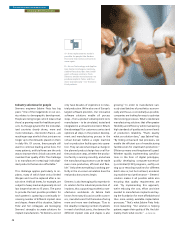Siemens 2013 Annual Report Download - page 58
Download and view the complete annual report
Please find page 58 of the 2013 Siemens annual report below. You can navigate through the pages in the report by either clicking on the pages listed below, or by using the keyword search tool below to find specific information within the annual report.-
 1
1 -
 2
2 -
 3
3 -
 4
4 -
 5
5 -
 6
6 -
 7
7 -
 8
8 -
 9
9 -
 10
10 -
 11
11 -
 12
12 -
 13
13 -
 14
14 -
 15
15 -
 16
16 -
 17
17 -
 18
18 -
 19
19 -
 20
20 -
 21
21 -
 22
22 -
 23
23 -
 24
24 -
 25
25 -
 26
26 -
 27
27 -
 28
28 -
 29
29 -
 30
30 -
 31
31 -
 32
32 -
 33
33 -
 34
34 -
 35
35 -
 36
36 -
 37
37 -
 38
38 -
 39
39 -
 40
40 -
 41
41 -
 42
42 -
 43
43 -
 44
44 -
 45
45 -
 46
46 -
 47
47 -
 48
48 -
 49
49 -
 50
50 -
 51
51 -
 52
52 -
 53
53 -
 54
54 -
 55
55 -
 56
56 -
 57
57 -
 58
58 -
 59
59 -
 60
60 -
 61
61 -
 62
62 -
 63
63 -
 64
64 -
 65
65 -
 66
66 -
 67
67 -
 68
68 -
 69
69 -
 70
70 -
 71
71 -
 72
72 -
 73
73 -
 74
74 -
 75
75 -
 76
76 -
 77
77 -
 78
78 -
 79
79 -
 80
80 -
 81
81 -
 82
82 -
 83
83 -
 84
84 -
 85
85 -
 86
86 -
 87
87 -
 88
88 -
 89
89 -
 90
90 -
 91
91 -
 92
92 -
 93
93 -
 94
94 -
 95
95 -
 96
96 -
 97
97 -
 98
98 -
 99
99 -
 100
100 -
 101
101 -
 102
102 -
 103
103 -
 104
104 -
 105
105 -
 106
106 -
 107
107 -
 108
108 -
 109
109 -
 110
110 -
 111
111 -
 112
112 -
 113
113 -
 114
114 -
 115
115 -
 116
116 -
 117
117 -
 118
118 -
 119
119 -
 120
120 -
 121
121 -
 122
122 -
 123
123 -
 124
124 -
 125
125 -
 126
126 -
 127
127 -
 128
128 -
 129
129 -
 130
130 -
 131
131 -
 132
132 -
 133
133 -
 134
134 -
 135
135 -
 136
136 -
 137
137 -
 138
138 -
 139
139 -
 140
140 -
 141
141 -
 142
142 -
 143
143 -
 144
144 -
 145
145 -
 146
146 -
 147
147 -
 148
148 -
 149
149 -
 150
150 -
 151
151 -
 152
152 -
 153
153 -
 154
154 -
 155
155 -
 156
156 -
 157
157 -
 158
158 -
 159
159 -
 160
160 -
 161
161 -
 162
162 -
 163
163 -
 164
164 -
 165
165 -
 166
166 -
 167
167 -
 168
168 -
 169
169 -
 170
170 -
 171
171 -
 172
172 -
 173
173 -
 174
174 -
 175
175 -
 176
176 -
 177
177 -
 178
178 -
 179
179 -
 180
180 -
 181
181 -
 182
182 -
 183
183 -
 184
184 -
 185
185 -
 186
186 -
 187
187 -
 188
188 -
 189
189 -
 190
190 -
 191
191 -
 192
192 -
 193
193 -
 194
194 -
 195
195 -
 196
196 -
 197
197 -
 198
198 -
 199
199 -
 200
200 -
 201
201 -
 202
202 -
 203
203 -
 204
204 -
 205
205 -
 206
206 -
 207
207 -
 208
208 -
 209
209 -
 210
210 -
 211
211 -
 212
212 -
 213
213 -
 214
214 -
 215
215 -
 216
216 -
 217
217 -
 218
218 -
 219
219 -
 220
220 -
 221
221 -
 222
222 -
 223
223 -
 224
224 -
 225
225 -
 226
226 -
 227
227 -
 228
228 -
 229
229 -
 230
230 -
 231
231 -
 232
232 -
 233
233 -
 234
234 -
 235
235 -
 236
236 -
 237
237 -
 238
238 -
 239
239 -
 240
240 -
 241
241 -
 242
242 -
 243
243 -
 244
244 -
 245
245 -
 246
246 -
 247
247 -
 248
248 -
 249
249 -
 250
250 -
 251
251 -
 252
252 -
 253
253 -
 254
254 -
 255
255 -
 256
256 -
 257
257 -
 258
258 -
 259
259 -
 260
260 -
 261
261 -
 262
262 -
 263
263 -
 264
264 -
 265
265 -
 266
266 -
 267
267 -
 268
268 -
 269
269 -
 270
270 -
 271
271 -
 272
272 -
 273
273 -
 274
274 -
 275
275 -
 276
276 -
 277
277 -
 278
278 -
 279
279 -
 280
280 -
 281
281 -
 282
282 -
 283
283 -
 284
284 -
 285
285 -
 286
286 -
 287
287 -
 288
288 -
 289
289 -
 290
290 -
 291
291 -
 292
292 -
 293
293 -
 294
294 -
 295
295 -
 296
296 -
 297
297 -
 298
298 -
 299
299 -
 300
300 -
 301
301 -
 302
302 -
 303
303 -
 304
304 -
 305
305 -
 306
306 -
 307
307 -
 308
308 -
 309
309 -
 310
310 -
 311
311 -
 312
312 -
 313
313 -
 314
314 -
 315
315 -
 316
316 -
 317
317 -
 318
318 -
 319
319 -
 320
320 -
 321
321 -
 322
322 -
 323
323 -
 324
324 -
 325
325 -
 326
326 -
 327
327 -
 328
328 -
 329
329 -
 330
330 -
 331
331 -
 332
332 -
 333
333 -
 334
334 -
 335
335 -
 336
336 -
 337
337 -
 338
338 -
 339
339 -
 340
340 -
 341
341 -
 342
342 -
 343
343 -
 344
344 -
 345
345 -
 346
346 -
 347
347 -
 348
348 -
 349
349 -
 350
350 -
 351
351 -
 352
352 -
 353
353 -
 354
354 -
 355
355 -
 356
356 -
 357
357 -
 358
358 -
 359
359 -
 360
360 -
 361
361 -
 362
362 -
 363
363 -
 364
364 -
 365
365 -
 366
366 -
 367
367 -
 368
368 -
 369
369 -
 370
370 -
 371
371 -
 372
372
 |
 |

– Before an implant is milled in
the real world, all production steps
are planned in a virtual environ-
ment and approved by the implant
manufacturer. Only then does the
machine tool begin production.
– At the Centre for Production
Technology at Leibnitz University
in Hanover, Germany, Professor
Berend Denkena and Sabine Fietz
discuss the challenges, opportuni-
ties and future of industrially pro-
duced implants.
1
2
“We all have to think more
like visionaries”
Professor Berend Denkena, who holds a
doctorate in engineering, is a machining
expert. He’s well aware of how important
absolute precision is in the field of medical
technology, where micrometer exactness
is a must. As head of the Institute for Pro-
duction Engineering and Machine Tools
at Leibniz University in Hanover, Germany,
Professor Denkena is working on a variety
of research and development projects in
medical technology and prosthetics.
In his view, Siemens’ solutions for the indus-
trial production of implants are an import-
ant advance – one that points the way to
the future. As he explains, the key is to inte-
grate the entire process chain from begin-
ning to end: “The problems are usually at
the interfaces – from product design, sim-
ulation and planning to the operation or
programming of the machine tools to the
actual production. For its products, Siemens
maps end-to-end process chains. And in
my opinion that’s a key prerequisite for suc-
cess.” Sabine Fietz adds: “However, we’re
already thinking about ways to continue
developing the process. Our goal is to
make implant production ever faster, more
efficient and cheaper. Why? Because the
standard implants used today can’t be ad-
justed to the bone conditions that physi-
cians discover only after an operation is in
progress. As things are now, surgeons ei-
ther have to remove healthy tissue or fill
damaged tissue with cement – in other
words, they have to adapt the patient to
the implant instead of tailoring the implant
to the patient. We’re working on solutions
that – building on an end-to-end, almost
fully automated process chain – may en-
able implant manufacturers and their part-
ners to produce prosthetics in the future
that are better tailored to individual patient
requirements. With rigorously improved
procedures, it could even become possible
to produce implants in hospitals while op-
erations are taking place.” In Professor
Denkena’s opinion, such a solution is quite
conceivable. “Implants are currently being
manufactured on conventional machine
tools. Even when the greatest possible care
is taken and the workpiece is sterilized
upon completion, contamination may oc-
cur. That’s why we have to find a way to
operate machine tools under sterile con-
ditions. But this will require a team effort
involving a wide range of experts from
different fields. And it will take time. Ulti-
mately, the best option would be to manu-
facture directly on site, but many chal-
lenges will have to be mastered before
that’s a reality.”
The improvements we’re developing are
intended to make procedures less burden-
some for patients by fitting the prosthetic
to the bone rather than the other way
around. Physicians will also benefit since
they’ll be able to optimize the implant
during surgery, once they’ve seen the joint.
“We all have to think more like visionaries,”
says Sabine Fietz. “Our solution shows
what production processes are going to
look like in the future. Modern software
solutions are bringing the virtual and real
manufacturing worlds closer together,
while creating unprecedented momentum
and flexibility. For our customers, that
means more efficient processes, shorter
time-to-market and, last but not least,
higher productivity at lower cost.”
Enhancing industrial productivity
Creating efficient solutions
